Miriam’s Well
Miriam’s importance as a redemptional model is highlighted by her association with water from the moment of her appearance in the biblical narrative (Exod.2:4). In rabbinic tradition, as in most surrounding cultures, water is seen as a salvific symbol; yet it is also regarded as having the potential of bringing death. In our text, the waters of the Nile caused death amongst the Egyptians during the Ten Plagues but because of Miriam’s courageous acts, they were life-giving waters for Moses and the Jewish people.[1]Berachot 56B הרואה באר בחלום ישכים ויאמר (שיר השירים ד׳) באר מים חיים, קודם שיקדמנו פסוק אחר, Norman J. Cohen, “Miriam’s Song A Modern Midrashic Reading”, Judaism 33 (1984) pp 181-2
Miriam’s two initiatives by the water’s edge[2]Exod 2:4, 15;20, Num 12:1, 20:1, 26:59, Dt 24:9, Mica 6:4, I Chron 5:29 are not the only reasons we associate her with water. In rabbinic literature we are told that Miriam contributed to the sustenance and well being of the nation in the desert, through water.
Rabbi Yossi in the name of Rabbi Yehuda said: Three great providers serviced Israel. They were Moses, Aaron and Miriam and three gifts were bestowed by them; the well, the cloud and the manna. The well (be’er) was in the merit of Miriam, the pillar of cloud in the merit of Aaron and the manna in the merit of Moses. When Miriam died the well disappeared as it says, Miriam died there and immediately thereafter it says The community was without water (Num.20:1-2).
(Taanit 9a)
One rabbinic tradition [3]Numbers Rabbah 1:2 actually sees Miriam’s well as a reward for her Song of the Sea. Moreover, commentators throughout the ages understood her well as a powerful rhetorical symbol. The significance of the itinerant well in its own right, can be understood by way of the Mishna in Avot (5:6) that lists it was one of the ten miracles created on the eve of Sabbath at twilight.
In his biblical commentary, Rabbi Samson Raphael Hirsh connects the well directly with Miriam’s exemplary character:
As the prophet (Micah) noted three people were sent to influence Israel, each with the virtue he outlines; doing justice, loving kindness, and walking humbly with God. Justice as a life style according to the will of God was the action of Moses, self-sacrifice for the sake of peace and kindness was the action of Aaron and modesty is the foundation of femininity in Israel, with modesty and purity Miriam exerted her influence. Perhaps this is represented by the holy well; kindness by the protective cloud shielding from the penetrating rays of light; and justice is the food the sustenance, and the strength in the existence of the nation.
(Hirsh, Commentary to Numbers 20:29)
Rabbi Bezalel Lowe[4]Known as the Maharal of Prague (1525-1609) developed the connection between Miriam and the well in terms of spiritual desire:
In the merit of Miriam the well, since there were those in Israel who longed to the exalted. This longing of the terrestrial for the celestial is like the desire of the female for the male, therefore Miriam was given the well– a feminine symbol of longing.
(Nezach Yisrael chapter 24)
Rabbi Kalonymos Kalmish Shapiro, (1889-1943), was a prominent Hasidic master in Poland during World War II. He taught Torah in the Warsaw Ghetto and after the war the manuscript of his writings – the Esh Kodesh was discovered and published. In his discourse on the Sabbath of Parshat Hukkat (in which the story of Miriam’s death is recorded) he elaborates on the theme of her well. He suggests that it represents the self-generated religious affirmation of women.
When a woman becomes a zaddeket, studies Torah and fulfills the commandments – that is her own accomplishment, since she is not under any obligation to do so: heaven has not really aroused her to do what she did…The fact that she reached such a high spiritual level is not attributable to divine elicitation but rather to her own self-generated effort…The source of her service is within her; it flows from her. That is why the well—source flowing with living water, holy water existed by virtue of her merit.
(Esh Kodesh, Num. 20:1,( June 27,1942) p.183)
Nehemia Polen in his article “Egalitarianism in Hassidic Thought[5]Modern Judaism 12 (1992) 1-21 p 7 explains :
This is the connection between the well and Miriam; the well was artesian, overflowing of its own, not needing to be primed or pumped. Similarly, Miriam’s spirituality was self-generated. Drawing upon her own inner resources and flowing from the depth of her being, it depended upon on other not even as it were the divine Other.
Polen points out that Rabbi Shapiro not only commends the initiative of Miriam the prophetess, but actually eulogizes his own wife Rahel Hayyah Miriam, who was, herself, a spiritually gifted Hasidic leader. Her untimely death took place on the Sabbath of Parshat Hukkat, in 1937 and inspired this revolutionary idea. By extension the explanation offered by the Esh Kodesh is meant to include all women who strive and attain spiritual heights.
The itinerant well of Miriam traveled through the desert for forty years. Tradition has it that with the demise of Miriam the well disappeared.
When Miriam died the well disappeared as it says, Miriam died there and immediately thereafter it says The community was without water (Num.201-2).
Shortly thereafter, the Torah records an interesting poem known as the Song of the Well.
Then Israel sang this song: (Az yashir Yisrael)
Spring up O well sing to it (enu la)
The well which the chieftans dug,
Which the nobles of the people started
With maces, with their own staffs.
(Num. 21:16-18)
Although the exact meaning of the song remains obscure Norman Cohen has argued that the song alludes to Miriam, her gift and the paradigmatic importance of her life, in what seems to be a kind of postscript to the story of her death. The poem of the well serves as a final tribute to Miriam, offered through song.
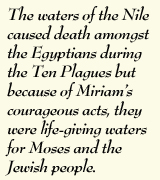
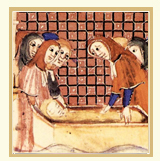
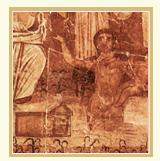
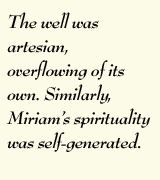
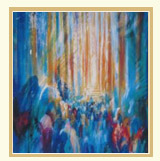
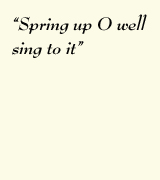
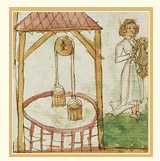
References
| ↑1 | Berachot 56B הרואה באר בחלום ישכים ויאמר (שיר השירים ד׳) באר מים חיים, קודם שיקדמנו פסוק אחר, Norman J. Cohen, “Miriam’s Song A Modern Midrashic Reading”, Judaism 33 (1984) pp 181-2 |
|---|---|
| ↑2 | Exod 2:4, 15;20, Num 12:1, 20:1, 26:59, Dt 24:9, Mica 6:4, I Chron 5:29 |
| ↑3 | Numbers Rabbah 1:2 |
| ↑4 | Known as the Maharal of Prague |
| ↑5 | Modern Judaism 12 (1992) 1-21 p 7 |